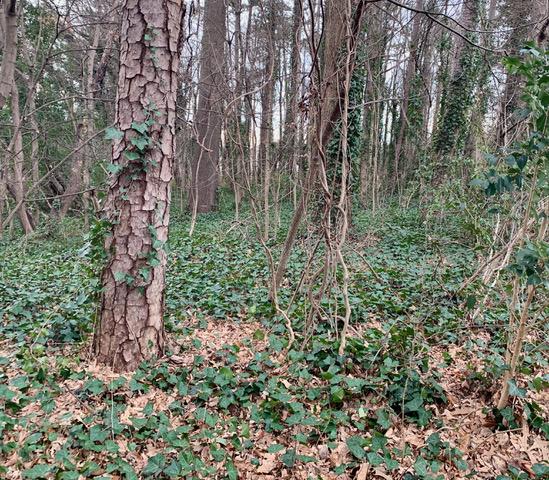By Lisa Lofland Gould
Editor’s note: In response to Julie Roberts’s effort to rid her property of English ivy, we asked our invasive non-native plant expert, Lisa Lofland Gould, to clue us in to why property owners would want to remove it or any other invasives. We often hear, “I can control it, why should I remove it?” Here is her response.
“. . . no matter how vigilant you may be in your own yard, you cannot control the birds or the wind and rain, and thus invasive plants are spread out onto the landscape. As always, it’s best to eradicate invasives and plant native plants!”
English Ivy (Hedera helix), a member of the Ginseng Family (Araliaceae), needs little introduction here in North Carolina, where it is common in the mountains and piedmont but less common on the coastal plain. Probably everyone recognizes its thick, waxy, evergreen leaves, which are alternate and have whitish veins. Young leaves have 3 to 5 lobes, while more mature leaves are unlobed, broadest at the base, and taper to a point at the tip.
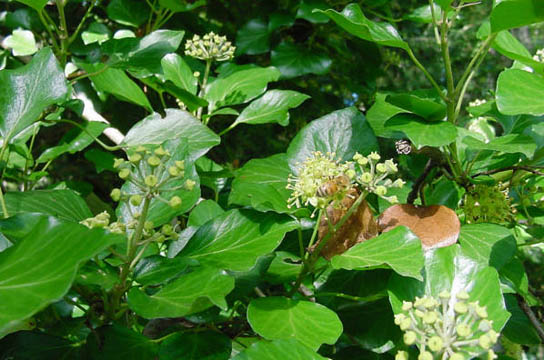
(Photo by Mary Baumeister)
English Ivy rarely flowers when it trails along the ground, but once a plant starts climbing upward it may bloom, producing rounded clusters of small greenish-yellow flowers (see photo above), followed by fruits that are bluish-black at maturity (although there are forms with yellow-orange fruits). The flowers are pollinated by bees and wasps.
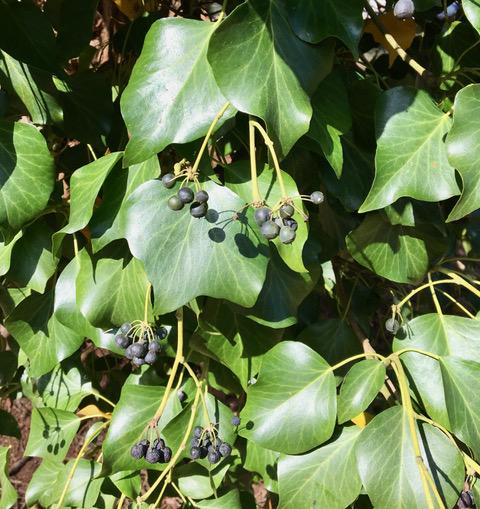
(Photo by Lisa Gould)
When English Ivy grows upwards it attaches to trees and shrubs (and buildings) with adventitious roots [roots that develop from non-root tissue] that secrete a substance that acts like glue, enabling the vine to continue its march upward. It will grow as high as there is available support. Once ivy is established in a shrub or tree, it blocks sunlight from the host plant’s leaves, inhibiting photosynthesis, weakening the plant, and eventually making it more susceptible to wind and storm damage (a recent power outage in my neighborhood was caused by an ivy-covered tree falling onto power lines). Its rootlets can penetrate bark, helping to introduce insects and diseases. English Ivy is a known reservoir for bacterial leaf scorch (Xyella fastidiosa), which gets into the water- and nutrient-conducting tissues (the xylem) of some trees (such as oaks, elms, sycamore, and maples) and can weaken or kill them.
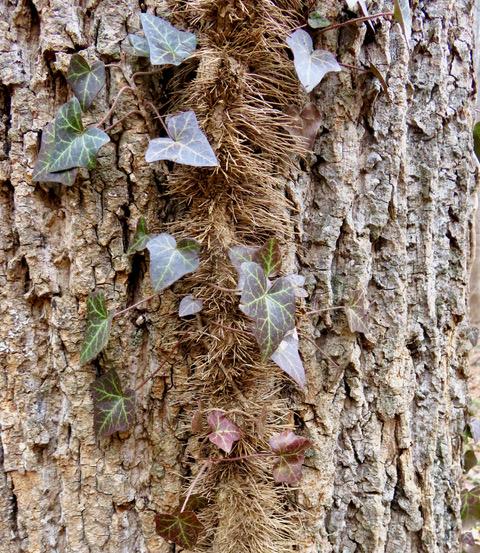
English Ivy fruit is eaten by birds, which disperse the seeds in their droppings. Both the fruit and leaves contain toxic compounds that can cause, among other problems, gastrointestinal distress including nausea and diarrhea, which may help avian dispersal of ivy fruit. The fruits and stem fragments are also spread by run-off water; ivy grows easily from stem fragments. When I was looking for a house in Winston-Salem, I was amazed at how many yards and trees were blanketed with English Ivy. My real estate agent quickly learned that I wasn’t about to buy a house with an ivy infestation in the yard! But even in the yard I have now, I constantly find English Ivy sneaking in, small plants here and there, no doubt a gift from the birds or a big rainstorm. This typifies invasive species: no matter how vigilant you may be in your own yard, you cannot control the birds or the wind and rain, and thus invasive plants are spread out onto the landscape. As always, it’s best to eradicate invasives and plant native plants!
English Ivy grows best in somewhat moist and fertile soils, from full shade to full sun; it will not thrive in very dry or saline soils. While English Ivy certainly will cover ground, it is not useful for erosion control: its roots may penetrate as deep as 4”, but usually are an inch deep or less, and water can flow beneath the plants on steep slopes, undermining the soil.
You can control English Ivy but it takes quite a bit of effort. Individual plants are more easily pulled up when the soil is moist, and there are methods for rolling up a large ground infestation. Some people have an allergic reaction to handling English Ivy, so it’s a good idea to wear gloves when pulling up plants. Vines that are climbing up trees should be cut at the base and then an herbicide (glyphosate or triclopyr are often suggested) applied to the cut stump. North Carolina State University and Clemson University both have more detailed information for controlling English Ivy.
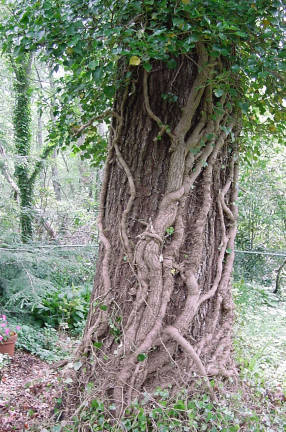
Introduced into North America in the early 1700s, English Ivy has since been widely planted as an evergreen groundcover and has naturalized throughout the eastern US and from Arizona to the Pacific coast states and British Columbia. Vascular Plants of North Carolina has records for English Ivy in 33 counties, but notes that it is “certainly under-collected and expected in many more counties, perhaps in all counties as an escape or adventive.” Persian Ivy (Hedera colchica), a close relative from central Eurasia, has been recorded in one NC county; another relative, Atlantic Ivy (Hedera hibernica), is a European native that is sometimes listed at Hedera helix var. hibernica. Its North Carolina status is unclear. Globally there are as many as 15 species of Hedera, all of them native to Eurasia and northern Africa, and there are more varieties and cultivars than you want to know about.
Whatever species/form of Hedera you might see in a nursery, PLEASE don’t buy it and plant it!
By Lisa Lofland Gould
Native Plant News – Spring 2022

Lisa Lofland Gould is a plant ecologist and co-founder of the Rhode Island Wild Plant Society; she currently serves on the NCNPS Board of Directors and chairs the Management Committee for the Emily Allen Wildflower Preserve in Winston-Salem.
